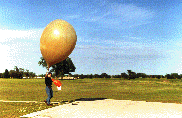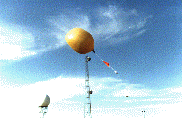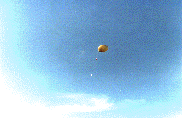:: books
:: gallery
:: data
:: blog
:: kids
:: shop
:: bio
:: help
:: contact
:: ChrisKridler.com


|
Words/images COPYRIGHT © 2021 by Chris Kridler. All rights reserved. Do not use Sky Diary photos on other Web sites. Personal use as computer wallpaper is permitted, but do not distribute photos. Write for information about purchasing video, photographs or articles. | Frequently asked questions |
tale of a tour: part 1
The following is a travel story I wrote about my first chase experience, which was with Cloud 9 Tours in the spring of 1997. A shorter version of the article ran in the The Baltimore Sun in early 1998. The contents reflect the experiences of a novice who is also new to chase culture, and it's written for a general audience that might be unfamiliar with chasing. The article is also divided into sections here for easier web-browsing.
Therefore, be advised that some of the contents may not reflect my current opinions or what any of the people mentioned herein are now doing (jobs, etc., may have changed). I have, however, snipped some verbiage from my original account. (Just think of it as the edited unedited version.)
Contents copyright 1997-1999 by Chris Kridler
by Chris Kridler
It's a May evening in the Texas panhandle, and daylight is running out. To the north, a towering storm cloud sprouts up and over our heads, hung with the little pockets of water vapor called mammatus, the hallmark of a violent storm. But that storm isn't the one we're after. We're after the tornado.
We're storm-chasing, and this, although we don't know it, is the best chance we'll have in a two-week tour to see a twister. Brilliant bolts of lightning are hitting nearby as our leaders jabber excitedly over the CBs, trying to figure out which storm to chase. South, we decide. We've been driving in huge circles all day, but finally, the reports on the radio indicate we might have a good one. Go south.
I grip the video camera, taking shots of orange clouds and lightning bolts out the passenger-side window of the Blazer and thinking about the soundtrack I'll dub on later. Let's rock and roll!
.....
Storm-chasing isn't your average vacation. It's not your average hobby, either. For the men and, occasionally, women who pursue it, it is nothing less than an obsession.
Long before "Twister," I'd been fascinated by tornadoes, and I knew vaguely that storm-chasing tours existed after seeing Marty Feely's Whirlwind Tours featured in TV specials. But chasing seemed a remote possibility until I did an idle Internet search at the technology pavilion on the Mall in Washington during the inaugural festivities in winter 1997.
Cloud 9 Tours came up. For a fee plus air fare, I could hang out with chasers on the Plains for two weeks and maybe, if I were really lucky, see a tornado.
Charles Edwards is the man in charge. A good-natured 30-something computer specialist at the University of Oklahoma in Norman, he would always rather be storm chasing. (Though he has many stickers on the back of his specially equipped Chevy Blazer -- from NOAA to the Tasmanian Devil to Skywarn -- none say exactly that.) He takes off work whenever the skies look promising, and for all of May and half of June, he devotes his time to running the small expeditions of Cloud 9 Tours.

This spring of 1997, it's he and fellow chaser Steve Courton who meet me at the Oklahoma City airport. Charles is tall, rangy and quiet, while Steve chatters at length about the prognosis for "good" weather -- the kind of weather the rest of Tornado Alley dreads. He and Charles discuss it further with Jim Leonard, a legendary tornado- and hurricane-chaser who meets us for lunch at what they affectionately call "the trough," Furr's Cafeteria.
As I will quickly learn, cafeteria-style lunches, truck stops, Mickey D's and dreaded Allsup's burritos are the norm for this bunch. No one goes storm-chasing for the food.
The guys think the forecast is grim, but they and the other chasers who will be lending a hand are still hopeful and excited that prime time has finally come: storm season. Seeing a tornado is fantastic, but it's the process -- the chase itself -- that is everything.
First, however, Cloud 9 must await the arrival of the rest of the tourists. Unlike the usual customers, these are not weather junkies. These are a dozen Germans who have won "Twister" video sweepstakes, accompanied by two handsome blond journalists from Bild whom one of the chasers lightly refers to as "the Aryan guys."

I get acquainted with my functional motel, the Guest Inn, and its adjoining Denny's in Norman, Okla. My balcony view isn't exactly romantic. It consists of a parking lot, some power lines and a dilapidated sign that once advertised an erstwhile Howard Johnson's.
I'm adjusting to the landscape. It's flat here. Really flat. But that's why it's so perfect for storms to develop -- and for people to chase them. On the East Coast, the few tornadic storms move quickly and are hidden by trees and hills. On the Plains, where in the springtime, chilly air from Canada presses south to slam into warm, moisture-packed air from the Gulf of Mexico, the volatile mix cooks up severe storms. The most dramatic of these is the supercell, a forbidding storm with an area of rotation, or mesocyclone, that can be more than five miles across. It is the ideal hatchery for a tornado.
Chasers from all over the country are drawn to the Plains this time of year. While they don't want to see a town razed by a twister, they definitely want to be there if one plows through a field.
The next day, Sunday, I get to see the University of Oklahoma's beautiful Earth Sciences building, which has fascinating geology displays and, even more interesting to the weather freak, a "map room" full of computers where meteorology students look at weather data on the Internet to come up with dew points, wind speeds and direction and radar images that help them make their forecasts.
I kill the rest of the afternoon with Steve at the Oklahoma City Zoo, where most of the inhabitants of the new wild cat exhibit are napping and hiding from the paying customers. They are, after all, cats, and it's excruciatingly hot. As we wait in line for a soda, I ask Steve what he does for fun when he's not storm-chasing. "Uh, well, nothing really interesting," he says. He thinks for a moment. "I can always chase hurricanes!"

We return to Norman, a southern suburb of OKC, to see the evening launch of a weather balloon at the National Severe Storms Laboratory. Such daily launches provide the lab and its Storm Prediction Center with some of the data needed to predict severe storms.
I go to dinner with a reporter and photojournalist from the Nashville NBC affiliate, Dennis Ferrier and Patrick Slattery, who will tag along with us for a week. We eschew cafeteria-style fast-food fare and eat at the Olive Garden. I've never been so happy to see Italian food in my life.
The gregarious Germans have arrived in two batches, one group via Vegas, and when I meet them, I suddenly feel like a foreigner in my own country. They know some English (certainly more than I know German), and from talking with them, I begin to realize two things: One, most of them don't care much about storms; in fact, some of them haven't even seen "Twister," the raison d'etre for their trip. Second, they don't really care if they find a tornado. They want to find Levis.
On Monday, I'm anxious for action. No such luck. We begin the sunny day looking at storm photographs lining the walls at NSSL, where we peer through a glass window at the forecasters in the Storm Prediction Center. (Unlike the lions at the zoo, they are not hiding.) The dramatic photographs of lightning and tornadoes only emphasize what we're missing. So instead of chasing tornadoes, we chase bison.
Our caravan of two rented passenger vans, photographer Lan Lamphere's van and the Nashville TV crew's rented four-by-four set out for the Wichita Mountains Wildlife Refuge in southwestern Oklahoma. There, buffalo -- descended, ironically, from animals purchased from the New York Zoological Society in 1907 after their near-extinction -- roam as once they did all over the plains. They are roaming pretty far from us, though. We stop, and one grouchy animal lumbers across the lonely road as we hover nervously by the vehicles, snapping pictures.
We drive to the top of Mount Scott. Charles calls it "the top of Oklahoma." The top isn't very high, but it sure is beautiful. Rugged rocks surround us, and sapphire-blue water sparkles in the green-and-brown landscape below.
On our way back to Norman, we stop at a souvenir shack to get something to drink and see the main attraction, a sad-looking rattlesnake in a cage. If this weather keeps up, it's going to be a long trip.
That night, I join half of the Germans for dinner. Lan, acting as Cloud 9's official videographer, drives. He runs Windchaser, a company that specializes in photography. Bitten by the bug, he's just picked up and moved his whole family to Norman from Alabama so that he can concentrate on storm-chasing.
At a local bar, we meet another chaser, Matt Biddle, a veteran of VORTEX (Verification of the Origins of Rotation in Tornadoes Experiment) and the entrepreneur behind Moderate Risk Chase Services, which escorts media crews on chasing junkets and sells T-shirts. It's not exactly Trump Enterprises, but it's a way to help defray the costs of chasing, which can be a very expensive hobby. I'm struck by how close this community is. For its denizens, talking about the weather isn't just idle chit-chat.
go to the main gallery page | go to storm chasers
go to reports from 2001, 2000, 1999, 1998, 1997



